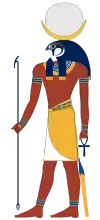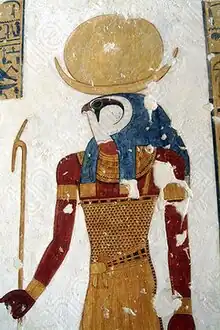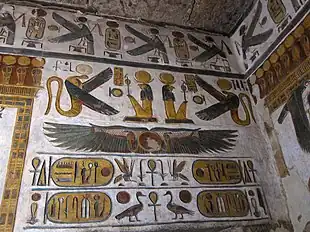Khonsu
Khonsu (Ancient Egyptian: ḫnsw; also transliterated Chonsu, Khensu, Khons, Chons or Khonshu; Coptic: Ϣⲟⲛⲥ, romanized: Shons) is the ancient Egyptian god of the Moon. His name means 'traveller', and this may relate to the perceived nightly travel of the Moon across the sky. Along with Thoth, he marked the passage of time. Khonsu was instrumental in the creation of new life in all living creatures. At Thebes, he formed part of a family triad (the "Theban Triad") with Mut as his mother and Amun his father.
| Khonsu | |||||
|---|---|---|---|---|---|
 Khonsu in falcon form, adorned with the moon disk and crescent moon. | |||||
| Name in hieroglyphs | |||||
| Major cult center | Thebes | ||||
| Symbol | the moon disk, the sidelock, falcon, crook and flail, was-scepter | ||||
| Parents | Amun and Mut | ||||
Mythology
Khonsu's name literally means 'traveller' and therefore reflects the fact that the Moon (referred to as Iah in Egyptian) travels across the night sky. He was also referred to by the titles Embracer, Pathfinder, Defender, and healer, and was thought to watch over those who travel at night. As the god of light in the night, Khonsu was invoked to protect against wild animals, and aid with healing. It was said that when Khonsu caused the crescent moon to shine, women conceived, cattle became fertile, and all nostrils and every throat was filled with fresh air.
Attributes



In art, Khonsu is typically depicted as a mummy with the symbol of childhood, a sidelock of hair, as well as the menat necklace with crook and flail. He has close links to other divine children such as Horus and Shu. He was also portrayed with the head of a falcon and like Horus, with whom he is associated as a protector and healer, adorned with the moon disk and crescent moon.[1]
| Part of a series on |
| Ancient Egyptian religion |
|---|
 |
|
|
Khonsu is mentioned in the Pyramid Texts and Coffin Texts, in which he is depicted in a fierce aspect, but he does not rise to prominence until the New Kingdom, when he is described as the "Greatest God of the Great Gods". Most of the construction of the temple complex at Karnak was centered on Khonsu during the Ramesside period.[1] The Temple of Khonsu at Karnak is in a relatively good state of preservation, and on one of the walls is depicted a creation myth in which Khonsu is described as the great snake who fertilizes the Cosmic Egg in the creation of the world.[2]
Khonsu's reputation as a healer spread outside Egypt; the Bentresh stela records how a princess of Bekhten was instantly cured of an illness upon the arrival of an image of Khonsu.[3] King Ptolemy IV, after he was cured of an illness, called himself "Beloved of Khonsu Who Protects His Majesty and Drives Away Evil Spirits".
In popular culture
_FRAME_by_shakko_01.jpg.webp)
Khonsu appears as a character in Marvel Comics, where the spelling of his name was changed to 'Khonshu'. In the comics, the character Moon Knight is the avatar of Khonshu and is also known as "The Fist of Khonshu".[4] Khonshu grants him supernatural abilities to fight evil in his name, but also slowly drives him insane. This is questionable as Khonshu's nature in the Marvel universe changes depending on how the writer portrays him for the story. In the past run, Doug Moench portrays Khonshu as a neutral figure. In later runs he is retconned to be a more active and malicious, but ambiguous and may be just a mental construct of Marc. Khonshu's character have been described differently to be a result of Marc's condition, a hallucination, something closer to another alter of Marc, or a complete separate and malicious alien parasite. Moon Knight's strength, endurance, and reflexes are enhanced depending upon the phases of the moon.[5] During Volume 2, Moon Knight is given special weapons by the cult of Khonshu.[6] Khonshu also appears in the Marvel Cinematic Universe (MCU) television series Moon Knight, voiced by F. Murray Abraham.[7]
In the film series Night at the Museum, Khonsu is mentioned to be the one responsible for creating the Tablet of Ahkmenrah in Night at the Museum: Secret of the Tomb during the secret story behind the tablet of Ahkmenrah. In the story the golden tablet was made by the high priest in the temple of Khonsu. The tablet was made using Khonsu's magic, which the tomb of Ahkmenrah was designed to channel Khonsu's rays in other words moonlight down to the tablet, rejuvenating its powers every night. The tablet has the power to bring all of the exhibits to life during the night, but if the tablet is away from "Khonsu's light [for] too long", all exhibits brought to life die.
Gallery
 Bas-relief of Khonsu (left) at the mortuary temple of Ramesses III
Bas-relief of Khonsu (left) at the mortuary temple of Ramesses III
 Relief representing Khonsu in the Temple of Khonsu, Karnak, 20th Dynasty
Relief representing Khonsu in the Temple of Khonsu, Karnak, 20th Dynasty Khonsu behind Rameses III offering to Amun, Temple of a million years of Rameses III
Khonsu behind Rameses III offering to Amun, Temple of a million years of Rameses III Khonsu depicted in the Temple of Kom Ombo
Khonsu depicted in the Temple of Kom Ombo Relief from the Sanctuary of Khonsu Temple in the Precinct of Amun-Re at Karnak Temple
Relief from the Sanctuary of Khonsu Temple in the Precinct of Amun-Re at Karnak Temple.JPG.webp) Khonsu depicted in the Temple of Kom Ombo
Khonsu depicted in the Temple of Kom Ombo Khonsu pendant
Khonsu pendant Granite statue of Khonsu, late 18th Dynasty, New Kingdom. Cairo Museum
Granite statue of Khonsu, late 18th Dynasty, New Kingdom. Cairo Museum Stele dedicated to Khonsu depicting offerings and worship, Dier-el-Medina, 19th dynasty
Stele dedicated to Khonsu depicting offerings and worship, Dier-el-Medina, 19th dynasty
See also
References
- Redford, Donald B., ed. (2003). The Oxford Guide: Essential Guide to Egyptian Mythology. Berkley. pp. 186–187. ISBN 0-425-19096-X.
{{cite book}}: CS1 maint: location missing publisher (link) - Pinch, Geraldine (2002). Handbook of Egyptian Mythology. ABC-CLIO. p. 156. ISBN 1-57607-242-8.
- This incident is mentioned in the opening of chapter one of Bolesław Prus' 1895 historical novel Pharaoh.
- Moon Knight #1. Marvel Comics.
- Marvel Spotlight #28. Marvel Comics.
- "Moon Knight: Fist of Khonshu #1 – Night of the Jackal. Marvel Comics. 1 June 1985.
- Leston, Ryan (15 February 2022). "Moon Knight Adds F. Murray Abraham as Khonshu". IGN. Archived from the original on 15 February 2022. Retrieved 15 February 2022.
External links
 Media related to Khonsu at Wikimedia Commons
Media related to Khonsu at Wikimedia Commons